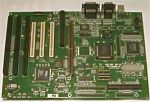

Developer: PIOS
Announcement: 1997 |
By the mid 1990s the PowerPC CPU had gained significant support; Apple
launched their first PowerMac in 1994, IBM were using it as an embedded
processor, and a common PPC hardware was being debated. The notion that
PowerPC could become a serious alternative to the x86 platform was a realistic
proposition.
The next two years strengthened these beliefs producing several interesting
announcements; the Common Hardware Reference Platform
was established and Apple were allowing third parties to license the MacOS,
LinuxPPC was gained considerable ground, and ProDAD had announced the development
of an Amiga-compatible OS. The future appeared
bright!
This is the market that a start-up called PIOS found themselves.
The company, consisting of former Amiga employees, John
Smith, Dr. Peter Kittel, Dave
Haynie, Andy Finkel, and others, intended to stake a claim in the expanding
PowerPC frontier. Using a combination of existing and new standards, PIOS
aimed to create an alternative to the WIntel market and a competitive PPC
machine. There was a sense of convergence that would allow Amiga, Macintosh,
and Atari owners to join forces and support one centralised platform.
| "The top board is a Rev 1 motherboard. This one had three ISA bus slots,
which were later removed. The three PCI slots were extended to six in the
"final" board. The next slot over is the Audio Slot, which was changed
to a digital audio expansion port instead. In both cases, the idea was
to augment the on-board audio with a cheap, multi-channel add-in. The final
slot is the CPU slot, naturally" * |
 |
| "The second card is the Rev 2 CPU module. The Rev 1 module supported
the older Motorola MPC105 "North Bridge" chip, this one supported the then
newer MPC106 chip. There's actually a real PowerPC 603 CPU on board here,
the PGA socket is essentially an expansion socket, for the standard PowerPC
"Interposer" module. This card would take three 64-bit DIMM modules for
main memory." * |
 |
The result was the PIOS ONE - a modular
approach to computing that would support cheap expansion solutions
(PCI, ISA, USB, etc.) and adopt a multiple OS solution - Mac users could
buy a PIOS One machine and MacOS, Amiga users could buy pOS,
etc. The operating system would differ, but the underlying hardware would
remain the same.
The multiple markets would increase competition and reduce consumer
costs.
Mac & Amiga: Unified against the WIntel threat!
The initial plan was to launch several variations for the Macintosh and
Amiga market. In an attempt to discover a 100% Amiga compatible OS, PIOS
delayed the launch of the TransAM (aimed
towards the Amiga market), and launched several Macintosh clones, such
as the low-end Maxxtrem and high-end Keenya. Negotiations
were planned with Viscorp to port the OS
to PowerPC.
By mid-1997, several manufacturers had signed for a Macintosh license.
However, the Apple management were having second thoughts about the licensing
agreement. In a contradiction to their previous
agreement the company requested licensees to pay higher royalties
or, in some circumstances, refuse to enter into new agreements for MacOS
8. This was followed by the cancellation of the cloning programme, due
to third party competition effecting Apple sales. The PIOS One machines
no longer had a market to compete in.
The PIOS One was dead in the water. Without Apple or Amiga to provide
an OS solution, it could only rely upon Be or Linux. However, Be were also
suffering in the PowerMAC market and were preparing to migrate to the x86
platform. It appears that the 'creative concept' was over..

In an attempt to distance themselves from the mistakes of the past,
PIOS relaunched itself as Met@box in August
1999. This was followed by a new long-term strategy with QNX to develop
set top boxes, data broadcast systems, and workstations. However, the company
only lasted another two years, initiating liquidation proceedings in 2001.
* text based upon Dave Haynie auction for the PIOS
One
RELATED LINKS
Early PIOS One specification list
What operating systems would the PIOS system
use?
The initial Pios Team
BACK
Last Update: 1/11/2001
|












